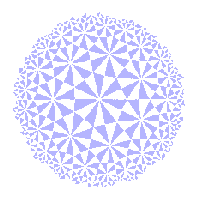For the moment, we will concentrate on the fundamental theorem, developing only such
results as are required for this purpose.
Notation
We refer to a "point" of RP2 as a p-point,
and a "line" in RP2 as a p-line.
Recall that a p-line is a plane through O, with the point O deleted.
The plane has an equation aTx = 0, where a
is a normal to the plane.
Theorem P0
If L is a p-line in RP2 and tεP(2), then t(L) is a p-line.
Proof
Let L have equation aTx = 0, and let
t([x]) = [Ax].
Then [x] ε t(L) if and only if t-1([x]) ε L,
i.e. [A-1x] ε L.
This occurs if and only if aTA-1x = 0, i.e. [x] is on the plane
with equation bTx = 0, where b = (A-1a)T.
Since this is a p-line, the result follows.
Thus, collinearity is an projective property. It follows that a list without collinear points
can only
map to another list without collinear points.
The Fundamental Theorem of Projective Geometry
If L = (A,B,C,D) and L' = (A',B',C',D') are lists of points of RP2, each with no three collinear,
then there is a unique element of P(2) mapping L to L'.
Much as in affine geometry, this follows easily from a special case with the four
standard points X = [1,0,0], Y = [0,1,0], Z = [0,0,1], U = [1,1,1] in one of the lists.
The (X,Y,Z,U) Theorem
If L = (A,B,C,D) is a list of points of RP2, with no three collinear, then
there is a unique element of P(2) mapping (X,Y,Z,U) to L.
proofs of the theorems
You can find out more about the projective group, including its
connection with perspective, and with affine geometry in later pages.
|
|

